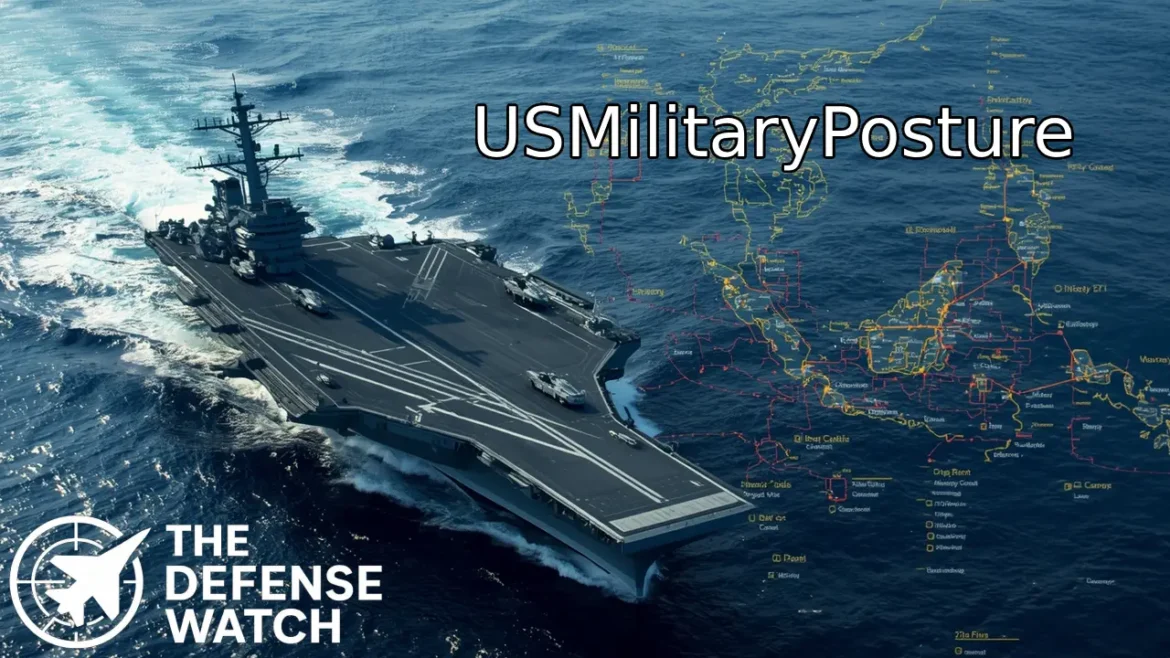The global security landscape is undergoing a fundamental transformation. As the Indo‑Pacific and NATO regions face rising challenges, the United States Department of Defense (DoD) is recalibrating how the United States Armed Forces engages with both major powers and regional allies. The U.S. must now juggle three complex tasks: maintaining a credible deterrent against peer competitors, enabling regional allies and partners to shoulder more of the burden, and preserving enough flexibility to respond to emerging threats. This analysis explores how the U.S. military posture is evolving in response to regional powers, what role allies are playing, and what trade-offs remain.
The Strategic Framework: From Hegemony to Regional Balances
For decades, U.S. strategy was shaped around sustaining global primacy and maintaining forward presence across multiple theaters. As noted by researchers at RAND Corporation, the “Regional Strategy” assumed the ability to fight two nearly-simultaneous major regional contingencies (MRCs) and preserve a baseline force posture.
Yet, the international system is evolving: shifts from bipolar to multipolar order, rising military technology diffusion, and new regional power dynamics all challenge the old assumptions.
In response, recent analysis highlights that the U.S. global posture review should focus on four priorities: defend the homeland, prevent the rise of regional hegemons, shift burden to allies and partners, and protect U.S. economic security.
Similarly, the U.S. Army War College outlines five strategic pillars to shape a force structure tailored to great-power competition—refocusing away from counter-insurgency and toward peer adversaries.
Thus, the overarching shift is clear: from global dominance via forward bases everywhere, toward more selective, regionally-balanced posture aligned with allies and tailored to adversaries.
Regional Powers in Focus: China, Russia and Others
China in the Indo-Pacific
In the Indo-Pacific, the U.S. faces its most consequential peer competitor in the People’s Republic of China. Analysts describe China’s military expansion—especially naval shipbuilding and advanced weapons—outpacing U.S. gains in key force elements.
At the same time, the U.S. posture is transforming: the Pacific Deterrence Initiative (PDI) commits over US$40 billion (fiscal 2021-24) toward Indo-Pacific deterrence—long-range fires, missile defence, distributed logistics.
Given China’s capabilities and assertiveness, the U.S. must strengthen relationships with regional allies while also shifting forces to regions of higher priority.
Russia and the Euro-Atlantic
In Europe, the invasion of Ukraine by Russia forced a re-examination of U.S. posture under United States European Command (EUCOM). A recent review suggests reducing the permanent U.S. force posture in Europe over the next decade while maintaining rapid-reinforcement capability via NATO.
This means the U.S. may rely more on European partners for forward defence while preserving the means to surge forces when needed.
Secondary Regional Powers: Iran, North Korea, Others
Other regional powers—from Iran in the Middle East to North Korea in Northeast Asia—exercise influence via asymmetric means rather than conventional force parity. Analysts note that these actors can shape U.S. posture indirectly via coercion, regional proxies, and strategic ambiguity.
The U.S. must prepare for both peer contests and regional contingency operations against less-capable but still disruptive adversaries.
Alliances & Partnerships: The Second Pillar of U.S. Strategy
Alliances remain a vital element of U.S. strategy. Rather than acting alone, the U.S. increasingly emphasizes burden-sharing, building partner capacity, and interoperability. In the Indo-Pacific, alliances such as the ANZUS Treaty, the Japan‑United States Security Treaty and new frameworks like AUKUS highlight the networked nature of regional defense.
In Europe, the U.S. remains embedded in North Atlantic Treaty Organization (NATO), but pressure is mounting for allies to assume greater forward defense responsibilities.
The focus now is shifting: less about U.S. boots on the ground everywhere, more about enabling partners and pre-positioning flexible capabilities.
Force Posture Trade-Offs: Where the U.S. Must Prioritise
The U.S. cannot simultaneously maintain large, permanent footprints everywhere and sufficiently fund advanced capabilities needed for peer competition. Analysts emphasise the trade-off between presence and readiness. For example:
- Maintaining large amphibious and ground units in low-priority regions may come at the cost of long-range missiles or cyber/space capabilities tuned for competition with China.
- Forward bases create automatic commitments; once troops are stationed, political pressure often prevents drawdown—even when the strategic environment shifts.
- Allies may free-ride if U.S. stays too large; conversely, reducing U.S. presence too much may undermine deterrence credibility.
Thus, the U.S. must carefully choose where to invest, where to posture forces, and where to rely on partners.
Current Posture Adjustments: What’s Changing Now?
Indo-Pacific
The U.S. is reinforcing its posture in the Indo-Pacific via the Pacific Deterrence Initiative, shifting logistics, and emphasizing distributed, resilient operations across the “first and second island chains.”
At the same time, some analysis calls for reduction of U.S. permanent ground forces from South Korea, and relocation away from the Chinese coast to reduce vulnerability.
Europe
Following the Ukraine war, the 2021 Global Posture Review reaffirmed a large U.S. presence in Europe. But subsequent analysis suggests a gradual drawdown of permanent forces while retaining surge capacity.
Pre-positioning and rotational presence may gain prominence over large forward garrisons.
Middle East & Others
The U.S. posture in the Middle East is being reconsidered: some analysts advocate reducing legacy deployments from the post-9/11 era and shifting resources to higher-priority regions.
With the U.S. homeland and Indo-Pacific increasingly taking priority, regions long considered core have slipped in relative priority.
Analysis: Strengths, Risks and Strategic Implications
Strengths
- The U.S. retains unmatched global reach—seven carrier strike groups, a global network of bases, and alliances that still span major regions.
- By bolstering partnerships, the U.S. can multiply its presence through allied forces, not just U.S. boots.
- Prioritising theatres like the Indo-Pacific aligns U.S. effort with its most consequential peer competitor—China.
Risks
- If the U.S. draws down too far in Europe or Middle East, regional deterrence may weaken and adversaries might exploit openings.
- Over-reliance on allies may backfire if partners cannot deliver or if their domestic politics change.
- The U.S. must still prepare for unexpected contingencies—such as a sudden crisis in Taiwan, or Russia launching a new offensive—while managing resources for long-term competition.
Strategic Implications
The evolving posture signals a shift from universal forward presence toward “selective engagement with ally-led networks.” The U.S. is voting with its spending and posture: allies must step up, regions must carry more burden, and the military must adapt for long-range competition and technology-driven warfare. Going forward, how the U.S. manages its force posture trade-offs—between presence, readiness and cost—will shape the balance of power well into the next decade.
Conclusion
The U.S. military is at a strategic inflection point. Faced with rising regional powers and a more complex alliance architecture, the United States is recalibrating its posture: focusing on the Indo-Pacific, reinforcing alliances, reducing some permanent commitments, emphasizing flexible and resilient capabilities. How well the DoD and U.S. policymakers execute this transition will determine whether the U.S. retains its competitive edge and supports a favorable balance of power with regional actors and allies in the years ahead.
FAQs
Military posture refers to how forces are organized, deployed and positioned globally—covering bases, forward presence, alliances, power-projection capabilities and contingency readiness.
Major competitors include China and Russia in the peer-category, while regional powers such as Iran, North Korea and other states exert influence regionally and affect U.S. posture indirectly.
Rather than the U.S. acting alone, allies are increasingly expected to take on frontline roles, host forces, and contribute interoperable capabilities—while the U.S. provides enabling, high-tech power and global reach.
The main trade-offs are between maintaining widespread presence vs investing in advanced capabilities; between permanent basing vs flexible deployment; and between readiness for peer conflict vs resource demands for that readiness.
Because China’s rise and its military modernization present the most consequential long-term challenge. Analysts note that what happens in the Indo-Pacific will shape global order in the 21st century.


10 comments
[…] The quantity and dispersion of mobile hypersonic launchers assigned in the U.S. force posture. […]
[…] Focus on niche strengths: A smaller navy should prioritise domain-specific missions (e.g., littoral submarine ambush/sea-denial) rather than replicate U.S. global SSBN posture. […]
[…] operational flexibility. The aircraft’s data link systems allow interoperability with U.S. and allied forces, while its beyond-visual-range (BVR) missile capability extends Taiwan’s air combat reach over […]
[…] Energy Ministry reported that the latest attacks resulted in scheduled power outages across most regions and called on citizens to rationalize electricity consumption, especially during morning and […]
[…] Reaction: How regional powers and international bodies respond will shape the legitimacy and feasibility of any […]
[…] in the Caribbean. According to defense insiders, however, the real objective appears to be strategic signaling to Maduro and his military allies. This approach reflects a pattern in former President Donald Trump’s foreign policy, often […]
[…] deterrence: The addition of advanced Abrams tanks bolsters Riyadh’s armored force posture in a region marked by simmering tensions, especially given proxy conflicts and […]
[…] could become a long-term burden for U.S. R&D and procurement — especially every time the regional balance […]
[…] The sale will not alter regional military balance […]
[…] in contested environments. IFF systems are critical for modern combat aircraft, allowing pilots and allied forces to distinguish friendly aircraft from potential threats, reducing the risk of fratricide during […]